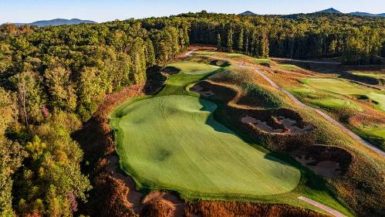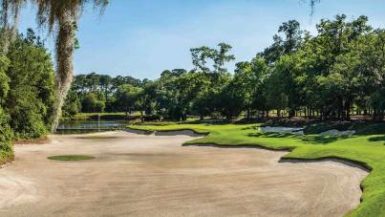PGA GOLF CLUB AT THE RESERVE
1916 Perfect Drive
Port St. Lucie, FL
800.800.GOLF
www.pgavillage.com
Architect: Pete Dye
Par 72
Excitement Level – 7/12
Difficulty – 8/12
Design: Five and 1/2 stars
Natural setting: Four stars
Conditioning – Six stars
Cost – $89 peak, $45 reduced
Yearly Memberships – No
Value – Six and 1/2 stars
Overall – Six stars
Tournament 6625 72.4 128
Standard 6030 69.3 123
Middle 5715 67.8 121
Forward 5015 67.8 109 SOUTH COURSE
Architect: Tom Fazio
Par 72
Excitement Level – 8/12
Difficulty – 6/12
Conditioning – Four and ½ stars
Cost – $89 peak, $45 reduced
Yearly memberships – No
Value – Four and ½ stars
Tees Yards Rating Slope
Medal 7076 74.7 140
Tournament 6606 72.2 137
Standard 6147 70.1 131
Middle 5590 67.4/73.2 122/126
Forward 4933 64.2/69.4 108/122
February in New York City isn’t all that bad when you’re in South Florida. While Florida has no shortage of golf courses, many have been criticized as being flat, uninteresting, repetitive and, worst of all, overpriced. Options for vacationing families who want both parents and kids to play every day are limited. Resorts such as Sawgrass and Palm Coast feature the best golf, but are on the highest end price wise. Orlando offers plenty of courses, but most are cookie-cutter designs and at an average of $120 a round per person, they are still a poor value. Some even crack the ridiculous $300 a round mark. The Tampa area is always a great option, but is not convenient to the beach and other vacation diversions. Happily, in 1996 the PGA of America opened the 54 hole PGA Golf Club at the Reserve and the accompanying PGA Village resort in Port St. Lucie. In doing so they not only opened a world class facility with every golf amenity under the sun, but also paid homage to the game’s egalitarian roots and provided families with a vibrant and affordable place to relax and immerse themselves in all aspects of the game.
PGA Golf Club is a celebration of all that is noble in our great game. The whole mission is to offer the optimum golf experience at an affordable price. A plaque at the entrance reads “Dedicated on September 17, 1996 as the home of the Professional Golfers Association of America and all who share the belief that golf is a game of a lifetime.” They succeed beyond all expectations. PGA Golf Club has everything – three highly acclaimed golf courses by top designers (two by Tom Fazio and one by Pete Dye), a six hole short course, phenomenal practice facilities, an enormous learning center, impeccable conditioning, a warm inviting atmosphere, great weather year round, a Village with housing and shopping, and best of all value. Prices never top $82 in high season, but $45 greens fees or lower are the norm for most of the year. Relaxed and unpretentious, yet fully devoted to providing a premium experience, the facility may be the most well-rounded and affordable option in Florida.
Of the three eighteen hole tracks, Tom Fazio’s South Course is the most popular layout and is the centerpiece course. This parkland style design features natural wetlands, wide, rolling fairways, traditional bunkering and idyllic lakes. (Five sets of tees)
The strongest design on the property is the more intimidating Dye Course, a polyphonic fusion of links elements such as enormous pot bunkers and tall native grasses seamless woven into a wetlands setting. Because of its non-conventional design features it gets less play than the South, and flies below the radar screen, but should not. Finally, the North Course, also designed by Fazio is similar to the South Course in style, but has even wider fairways and less challenging green complexes then its more celebrated sisters. At each course, five sets of tees offer challenge to all levels of player.
ON THE COURSES
People make the mistake of being intimidated by the Dye Course. Some are flustered by the mildly linksy feel. Others simply play the wrong set of tees. The gold tournament tees appear negotiable at just over 6600 yards, but Dye demands accuracy as well as length and hazards are more lethal at the severe angles players face from the golds. The white tees appear short at 6030 yards, but approaches still need to be accurate. Nevertheless, the course is easier than it looks and becomes ever more playable and lovable with each passing round. In true links fashion, the course does not return to the clubhouse after a loop of nine holes, unlike the other courses. Once players leave the first tee, they do not return to the clubhouse until the end of the round.
The first hole, a short par four presents the theme of the course admirably. Perhaps the widest fairway on the course is framed by heaving mounds and vast sandy waste areas while being peppered with pot bunkers. The course begins in earnest at four, a short dog-leg right par-4 which curves cape-style around a lake. Any slice is doomed. The long par-5 fifth features another water hazard along the right and an enormous ski-jump shaped pot bunker six feet high in the middle of the fairway. (See picture). The sixth is the best par three on the course. All carry over native grasses and a swamp to a kidney shaped green cut obliquely from left to right. The green has three distinct tiers.
Holes seven through thirteen continue to weave their way through expansive waste bunkers, devilish pot bunkers, fields of native grasses, towering dunes and natural wetlands. Highlights include an other-worldly bunkered dunescape to play over at the par-5 seventh, the long and demanding par-4 ninth and the serene par-3 thirteenth.
Dye loves a difficult and dramatic finish and the closing stretch of 14 through 18 is relentless. Experts have the worst of the challenge. From the back tees, the last two par-4s, 15 and 18 are 480 and 475 respectively. Throw in a 225 yard par-3 over water at 16 and a 565 yard par-5 at 17 and players may wish they had the chance to creep off to safety after nine. From the middle tees, the distances are more manageable with the last three par fours all under 400 yards.
SOUTH COURSE
Tom Fazio’s South Course has a more familiar Floridian look and feel with palm trees swaying, serene wetlands guarding fairways and greens and native love grasses framing the holes. Far prettier and more familiar than its pagan brother, the South is the most popular choice with visitors. A few houses appear lining some holes, but they are well recessed from the fairway and only appear infrequently, so who cares. The first three holes are an easy warm-up if players avoid the only hazard, the lake that guards the left fairway and green on the long par-4 second hole.
The course begins in earnest at four, a gorgeous par-3 which features a carry over beautiful wetlands hazard as well as a waste bunker. Holes five through eight tack back toward the clubhouse, playing along a devilish creek all along the left hand side of the stretch while traditional parkland style bunkers narrow the corridors of play and define the landing areas. Greens are large and multi-tiered and impeccably conditioned. On the back, highlights include the beautiful par-311th, the terrific risk-reward par-5 13th with huge bunkers guarding an uphill approach and a water hazard guarding the whole right side, and the short but dangerous par-4 15th, which is driveable, but any shot right finds the lake.
CHIP SHOTS AND TAP-INS
PGA Golf Club is so much more than just great golf. There is a historical center, a state of the art learning center, an executive course and terrific lodging at the PGA Village villas. Director of Golf Bud Taylor.






I will have to take a trip to this one. One of those 4-day weekends will do fine. This sounds like a great place to visit.
I really enjoyed the Dye course, in particular the central hazards, course doesn’t get the praise it deserves. Played one of the other courses and it was too friendly a design to be interesting to play.